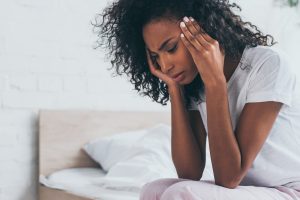
BY ANNETTE BROOKS
It’s estimated that up to 39 million people in the United States live with migraine headaches. If you or a loved one are in this group, keep reading to learn more about these complex brain events, including symptoms, triggers, and treatment options.
Symptoms and Potential Causes
Although migraines affect everyone differently, attacks last from four to 72 hours and range from tolerable to highly debilitating. Symptoms usually include a throbbing, pulsing headache on one side of the head. Nausea, vomiting, fatigue, and sensitivity to light may also occur.
Around one-third of migraine sufferers can predict the onset of a migraine because they experience auras, which usually occur before head pain and last up to an hour. They include visual disturbances such as blind spots, tunnel vision, and seeing flashing lights, zig-zag lines, sparkles, or stars. Auras may also involve changes in smell, taste, touch, or speech. One type of migraine — a silent migraine — doesn’t involve head pain but includes auras.
Genetics play a role in migraines, and lifestyle factors can trigger attacks. They include stress, change in sleep patterns, skipping meals, changes in routine, alcohol, and hormonal changes. Additionally, certain conditions such as temporomandibular joint disorder (TMD) can worsen migraine headaches. Sex also plays a role, with women two to three times more susceptible to migraine than men.
Treatment Options
Migraine attacks remain an enigma because there’s no definitive cause or cure. However, the good news is that migraine treatments are evolving rapidly. In fact, the 2022 Migraine World Summit lists over 300 medical treatments and alternative therapies for migraine, from preventive supplements like Coenzyme Q10 to new medications, neuromodulation devices, and Botox. Ask your physician to review treatment options with you and explain how each works.
Medications – Prescription drugs for migraine are either acute (abortive) medications designed to stop a migraine attack if taken as soon as you notice symptoms or preventive, meaning they’re designed to reduce the frequency and severity of expected attacks. Acute migraine treatments include a variety of drugs, including triptans (serotonin receptor agonists), ergotamine derivatives, gepants, ditans, nonsteroidal anti-inflammatory drugs (NSAIDs), and analgesics. Preventive treatments include anticonvulsant drugs, triptans, CGRP monoclonal antibodies (mAbs), beta-blockers, and angiotensin receptor blockers.
Devices – SPG stimulation devices, implanted by your doctor, stimulate a small bundle of nerve cells behind the nose called the sphenopalatine ganglion (SPG). External neuromodulation devices that deliver an electrical current to either lessen or raise nervous system activity include Cefaly, which works on the trigeminal nerve, Nerivio, which you wear on your upper arm to modulate the body’s pain-regulatory system and control with your smartphone, and gammaCore. GammaCore Sapphire is a small, FDA-cleared, non-invasive handheld device that treats and prevents migraine by activating the vagus nerve with gentle electrical stimulation through the skin.
Botox – OnabotulinumtoxinA was approved in 2010 for adults who experience chronic migraine attacks. Doctors inject it into multiple spots around the head and neck to help stop muscles from tensing and prevent the onset of migraine. Results last around three months, so regular injections
are required.
Migraine Fast Facts
- There’s no complete cure for migraine because the cause is complicated and not fully understood.
- Migraine frequency has risen during the COVID-19 pandemic.
- Migraine runs in families. Up to 80% of people with migraine headaches have a first-degree relative with the disease.
- Migraine risk is highest in 35-to-45-year-olds, although they can affect people of all ages, including children. According to John Hopkins Medicine, the average onset for migraines in children is around age seven for boys and 10 for girls.
- People diagnosed with chronic migraine have headaches at least 15 days each month, and at least eight are migraines.
- Studies indicate that migraine headaches are often misdiagnosed. Some studies suggest that less than half of those suffering from migraine get an accurate diagnosis. Misdiagnoses include tension headaches, an inner ear disorder, medication overuse, and sinus infection, to name a few.
Keep a Migraine Symptom Journal
Tracking symptoms and triggers can help your doctor figure out the type of migraine you’re experiencing, evaluate the effectiveness of treatments, and make adjustments if necessary. There are a variety of convenient mobile apps you can use to log each migraine, including Migraine Buddy, Migraine Monitor, N1-Headache, and Migraine Healthline. (Links below)
Migraine Buddy
https://apps.apple.com/app/apple-store/id975074413?pt=99018807&ct=website_home_hero&mt=8
https://play.google.com/store/apps/details?id=com.healint.migraineapp&referrer=utm_source%3Dmb_website%26utm_medium%3Dhome_page%26utm_content%3Dbutton%26utm_campaign%3Dhero%26anid%3Dadmob
Migraine Monitor
https://itunes.apple.com/us/app/migraine-monitor/id1098739519
https://play.google.com/store/apps/details?id=com.migrainemonitor
N1-Headache
https://itunes.apple.com/us/app/n1-headache/id925671723?mt=8
https://play.google.com/store/apps/details?id=com.curelator.headache
Migraine Healthline (Bezzy Migraine)
https://apps.apple.com/US/app/id1494062954?mt=8
https://play.google.com/store/apps/details?id=com.healthline.mig&hl=en_US&gl=US










